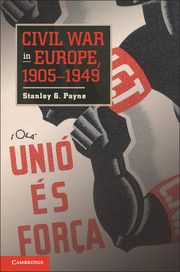Book contents
- Frontmatter
- Contents
- Preface
- Chronology of Events
- Glossary of Political Acronyms
- Introduction Revolution and Civil War as Forms of Conflict
- Part One World War I and An Era of Internal Conflict, 1905???1935
- Part Two The Conflict In Spain, 1931???1939
- Part Three Civil War and Internal Violence in The Era of World War II
- 8 The Multiple Wars of Europe, 1939???1945
- 9 The Civil Wars in Yugoslavia and Greece
- Conclusion
- Index
- References
Conclusion
Published online by Cambridge University Press: 05 June 2012
- Frontmatter
- Contents
- Preface
- Chronology of Events
- Glossary of Political Acronyms
- Introduction Revolution and Civil War as Forms of Conflict
- Part One World War I and An Era of Internal Conflict, 1905???1935
- Part Two The Conflict In Spain, 1931???1939
- Part Three Civil War and Internal Violence in The Era of World War II
- 8 The Multiple Wars of Europe, 1939???1945
- 9 The Civil Wars in Yugoslavia and Greece
- Conclusion
- Index
- References
Summary
The first half of the twentieth century was the time not only of the most extensive international violence in European history but also of the greatest internal conflict. When that period ended, the era of classical modernity would soon begin to come to a close, and the factors that stimulated the world wars – outlined at the beginning of this book – had also for the most part begun to pass from the European scene. Intense nationalism, the rivalry of multiple empires and would-be empires, the ideologies based on vitalism and conflict, and autarchist economic competition had all either disappeared or were in serious decline. The transformation of the media and information technology helped to bring to an end the classic age of political propaganda, while the quantum leap in weapons technology discouraged direct war between the powers. Thus stage three of the twentieth-century world revolutionary process did not bring World War III but the much different Cold War – long, expensive, and destructive, but not another military holocaust.
- Type
- Chapter
- Information
- Civil War in Europe, 1905–1949 , pp. 225 - 232Publisher: Cambridge University PressPrint publication year: 2011



